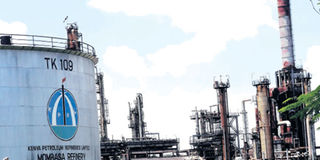200 jobs at stake as refinery converts to storage facility

The Kenya Petroleum Refineries Limited plant in Mombasa. PHOTO | FILE | NATION MEDIA GROUP
What you need to know:
- Since June, an inter-ministerial committee has been researching on the best model that the government can use to revive the refinery whose operations were shut down in September 2013 following a disagreement between Essar Energy of India and the government, the two equal shareholders of the facility.
- Sources privy to the goings-on say the final report of the inter-ministerial committee recommends that the refinery be retained to serve the country when it turns to producing oil.
The fate of about 200 employees of the Kenya Petroleum Refineries Limited (KPRL) hangs in the balance as the Government converts the Mombasa facility into an oil storage unit.
On Wednesday, senior officials at the Ministry of Energy and Petroleum held a meeting with the boards of KPRL and Kenya Pipeline Company (KPC) in which the new business model was communicated.
No direction was given on how the workers will be absorbed into the new system or whether some will be laid off.
In a telephone interview with the Smart Company, Petroleum principal secretary Andrew Kamau said the process is still at an early stage and the fate of the employees will be known in due course.
“We have an idea on what we want to do but we want expert advice to define the finer details of operation. All the employees there have specialised skills which remain useful even in the proposed mode of operation,” said Mr Kamau.
Since June, an inter-ministerial committee has been researching on the best model that the government can use to revive the refinery whose operations were shut down in September 2013 following a disagreement between Essar Energy of India and the government, the two equal shareholders of the facility.
The taskforce comprised 11 members drawn from the National Treasury, Ministry of Energy, KPC, KPRL and the Energy Regulatory Commission.
The committee was expected to present its final report to authorities at the Energy ministry on Wednesday but the meeting was postponed after it was said that some of the members accompanied President Uhuru Kenyatta to Israel.
However, the Smart Company has learnt that the meeting with the boards of KPC and KPRL was hurriedly convened and that the representatives of Essar Energy on the KPRL board did not attend due to the short notice.
Sources privy to the goings-on say the final report of the inter-ministerial committee recommends that the refinery be retained to serve the country when it turns to producing oil.
Industry estimates show that it would cost $1.9 billion to refurbish the Mombasa refinery which has a capacity of cleaning up to 80,000 barrels of crude oil daily. It will cost about $4 billion to build a new refinery in Uganda with a capacity of 30,000 barrels a day.
Kenya is to take up 2.5 per cent shareholding of the proposed refinery.
Tight spot
“The government is on a tight spot; on one hand, it makes business sense to retain the Mombasa refinery and refurbish it for purposed of refining the type of crude we have locally. On the other side, it has already committed to exporting oil through the port of Lamu which is linked to the Uganda refinery.
“With the refinery located in Changamwe, it makes it difficult to utilise the Mombasa port,” said a source within the committee who spoke on condition of anonymity.
By converting the refinery into an oil storage capacity, KPC is expected to take over operations of KPRL and manage it as one of its outfits.
KPC is wholly owned by the government and its core mandate is to ensure smooth supply of petroleum products in the country, including investment in storage facilities.




